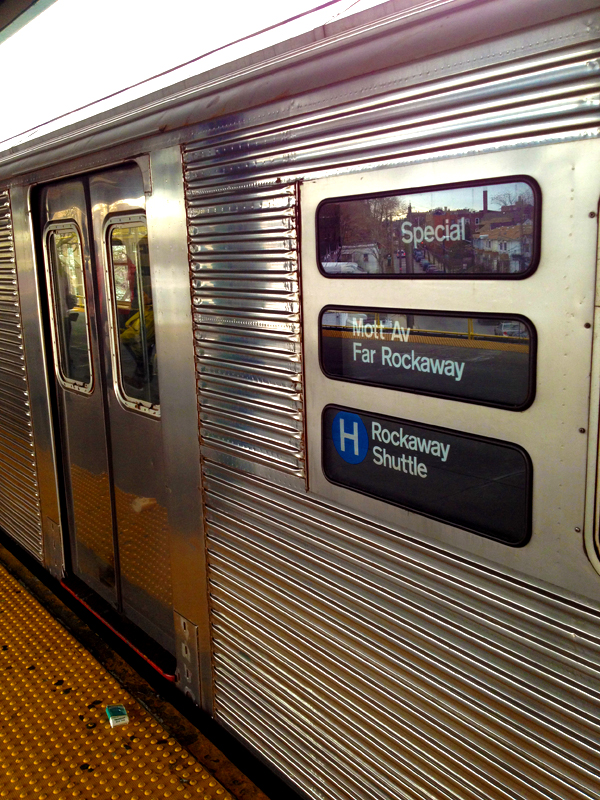By Octavio Blanco (@OctavioCNN)
[blackbirdpie url=”https://twitter.com/OctavioCNN/status/274963393583120384″]
I’d have been suspicious of me.
Here I was, a stranger with no identifying jacket, or armband, or hat, or badge, walking around, alone, knocking on doors asking questions with an iPhone in-hand and logging answers and addresses into my shiny device.
“Good morning, I’m a volunteer with the United Way of New York conducting a survey of residents’ evolving needs after the storm. The information is to be used by State, Federal and Non-profit agencies. Can I take ten minutes of your time and ask you a few questions?”
That’s how I explained my presence on their doorstep. I was assigned a two-block area, Beach 91st and Beach 92nd streets, between Beach Channel Drive and Rockaway Beach Blvd, near the Thai Rock restaurant.
But to my surprise, the vast majority of the residents there opened their doors and answered the intrusive questions. They were friendly, kind, gracious people, eager to respond. Many here are firemen. They’re strong, resilient folks.
“Do you have food?”
“Yes.”
“Do you have water?”
“Yes.”
“Do you have electricity?”
“Yes.”
The blocks are mostly composed of detached single- and multi-family homes. Beach 92nd street was particularly striking because of how clean and ordered it was. No debris was visible on it. I was almost tempted to say that things were fine here.
The survey questions made me feel silly. They seemed outdated, out of tune. But upon a closer inspection, things were not as fine as they seemed – not by a long-shot. While residents here had food, water and electricity, some were still without heat.
A retired fireman told me he’d recently switched to natural gas after the storm. “I have heat but my brother-in-law still doesn’t. I called a contractor. He’s still waiting on Rapid Response,” he said.
After the survey we sat a bit, chatting about how his family weathered the tempest. His bushy mustache framed a determined smile. It was a smile, I thought, Chiseled into his face from years of work as a rescuer. I imagined it would have been especially reassuring to see it if I’d been trapped in a burning building.
As the ocean flooded his basement, he recounted, his oil tank had leaked all over. That’s when I finally pinpointed the smell that permeated his home.
In this section of Far Rockaway, things were coming along, but lots of people still didn’t have heat. Those that did, had it because of their own effort and expense.
Those relying on the city were still waiting for heat.
One family – a mom, dad and two-year-old – like many of their neighbors, were using space-heaters for warmth as they waited for “rapid response.” The father was a 41-year-old filmmaker who made a documentary about Far Rockaway’s surfer culture. The family had only recently bought their home.
They weren’t worried about the heat, it was on the way. They were OK, they said. Once again, a block away, amid the grim recovery, there were smiles. But the optimism was tempered by the long legal, financial and emotional journey they now faced.
As I left the home I noticed two guys in a brand-new Mercedes going door-to-door giving away space-heaters.
Recovery on Far Rockaway has been uneven.
Many have it a lot worse than the area I visited on Saturday. One of the volunteers in charge of organizing the collected survey data told me that many of the poorest folks still don’t have access to food, or water, or electricity. “It’s disgusting.”
But regardless of socio-economic status, all residents of Far Rockaway face a daunting bureaucratic nightmare.
They are juggling FEMA applications, insurance claims, and disaster unemployment assistance, just to name a few issues. Landlord/tenant problems are becoming more pervasive as slumlords drag their feet to make repairs to damaged homes, many of which still lack electricity, heat, and hot water. For the poorest, food is still not easily accessible. Even in the middle-class area I was in, the supermarket had only been open for a day or so. Folks that don’t have cars or money to shop or friends to give them rides are still dependent on the food pantries and hot food tables offered by volunteers.
A new phase of volunteering is gaining momentum: legal guidance.
There is free legal help available for residents to navigate the bureaucracy, but I worry that they don’t know about it. So I want to try and get the word out and I’m starting here, by listing a few resources I’ve found:
1) The definitive disaster legal assistance manual from Legal Services NYC (PDF): http://bit.ly/X1wETh
2) A calendar of upcoming law clinics, New York Free Disaster Assistance Legal Clinics: http://www.mynewyorklegalhelp.com/nydisasterlegalclinics/
3) For law help including general information about disaster relief – Disaster relief for small businesses and not-for-profit organizations – Disaster unemployment assistance (DUA) and other work problems related to Hurricane Sandy – FEMA disaster assistance – Food stamp replacement – Homeowners: insurance and foreclosures – Immigrants affected by Hurricane Sandy – Tenants affected by Hurricane Sandy: http://bit.ly/UcLYc6
4) Follow the NY Bar’s blog – City Bar Justice Center news: http://bit.ly/Q88pyz
5) For lawyers and non-lawyer volunteer opportunities – Hurricane Sandy Legal Relief Efforts: http://www.probono.net/ny/hurricane_sandy/
Related:
The Far Rockaway Blues: Dispatches From the Frontlines Part I
Hurricane Sandy: An Uptown Perspective
Pics From the People: Hurricane Sandy – The Aftermath
We invite you to subscribe to the Uptown Love newsletter, like our Facebook page and follow us on Twitter, or e-mail us at [email protected].

